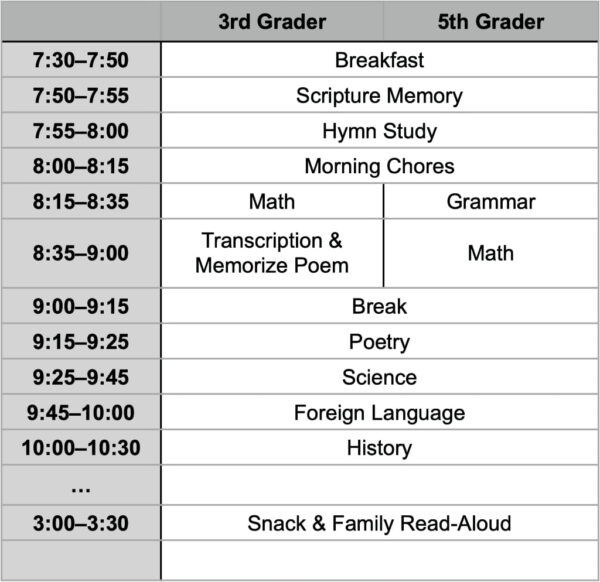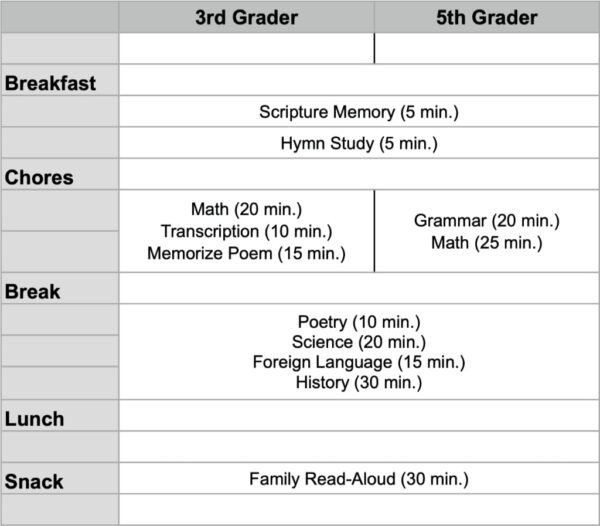60-day returns • free shipping on USA orders $129+
Today I’d like to walk through two different ways to schedule a school day. Both are viable options. Use the one that fits best during this season of life. Over the years—or even during different terms of a single year—you might find that one of these works better at that moment. Feel free to switch between the two options as desired. Use them as tools.
The two options are time tables and time boxes. Let’s talk about time tables first.
Time Tables
Many of us are familiar with this type of daily schedule from our own school days. Most schools set up their daily schedules on a time table. The key is that word “time.” Every class or activity is assigned to a time on the clock. You start at a certain time and you end at a certain time. And you can set up your home school like that. You can run each day on a time table schedule.
Here is an example of a time table for a homeschool day. Keep in mind that you would do different subjects on different days, so the time table might look different for each day; but this gives you an idea of what I mean by “time table.”


Let’s say this home school has a 3rd grader and a 5th grader. On this particular day, they will have breakfast together at 7:30. Then they do their Scripture Memory from 7:50–7:55 and sing their hymn at 7:55.
At 8:00 they are dismissed to do their morning chores: make beds, brush teeth, do breakfast dishes, whatever.
At 8:15 they begin their individual work. Mom can work with the 3rd grader on math while the 5th grader does a grammar lesson and perhaps studies the dictation passage that goes with it. At 8:35 they switch, and Mom goes to help the 5th grader with math while the 3rd grader works on a transcription passage and the poem he is memorizing that term.
At 9:00 they have a 15-minute break. Then at 9:15 they regather to read and discuss a new poem. At 9:25 they review, then read and narrate from their science book. At 9:45 they have a Spanish lesson, and at 10:00 they review, then read and narrate from their history book. At 10:30 they are done with that schoolwork. Later on in the day, at 3:00, they will have a snack and their family read-aloud.
You can see how every subject has its assigned time slot. Charlotte Mason used time tables for her schools. It’s a great way to keep everything organized and make sure the students know what is expected. Having a posted beginning and end time reinforces the habit of paying full attention, because there is a sense of urgency in knowing that you have only this much time to complete that lesson.
I think having that structure is vital in our home schools. If you have posted what should happen when, that relieves everyone from the effort and distraction of figuring out “What should we do next?” and “When will we get to this?” every day. Making those decisions ahead of time frees your mind to concentrate on what you’re learning rather than when you’re going to learn it.
Time Boxes
But there is another way to keep that structure in your home school but add a little more flexibility. That option is called time boxes. Time tables can be very helpful, but they can also add a lot of stress in some situations; such as, when you have a baby in the home or when you’re struggling with chronic illness or if you’re running a family business. So many areas of life just run smoother if you have flexibility to do what needs to be done in the moment. And that’s especially true of homeschooling.
So let me show you that same day’s work but as a time-boxes schedule.


First, you decide what your anchors are going to be. You can see those listed on the left. The anchors are events that happen every day no matter what. Then you think of the time between those anchors as boxes. You have a box of time between breakfast and chores. You have another box of time between chores and break. Another box between break and lunch; one between lunch and snack; and you could continue the day with more anchors if you needed to, adding supper and bedtime. The main thing is to think about your day as a collection of time boxes between those anchor events.
Then you just assign your day’s subjects to the various time boxes. So after breakfast and before we do chores, we will do Scripture Memory and hymn singing. After chores, we will do individual work, which you see listed. (These are the same assignments as on the time table example.) After that individual work is done, we will take a break and then regather for the Family subjects you see there. When those are done, we’re free until snack time.
You notice that we still have a time limit listed for each subject. That time limit encourages that sense of urgency and the habit of full attention; the only difference is that it’s not tied to a set time on the clock. You can start the science lesson at 9:25 or at 10:07—whenever you are ready for it. But you’re still going to allow only 20 minutes to work on it.
After the science lesson is done, you’re going to do a foreign language lesson. But you might need to go change the baby’s diaper first. If so, no problem. With a time boxes schedule, there is no pressure; you don’t have to hurry through those common life happenings and feel guilty that you’re “behind” on your schedule. When you’re ready to start the foreign language lesson, set a time for 15 minutes, or glance at the clock and make a mental note of when that 15 minutes will be up, and then focus on the lesson.
You still have structure. You still know what you’re going to do and in which order, arranged to use different parts of the brain and body. You still do the short lessons that Charlotte Mason prescribed. The main difference is that you’re not letting the clock be the dictator.
Now, for some families and during some seasons of life, maybe it will work best to let the clock be the dictator. Then do that! The point is that you have options. Set up your daily schedule to fit your family. Whether that is a time table schedule or a time boxes schedule it’s up to you. Now that you know about both of those tools, choose the schedule that will work best.
I talk more about these two types of schedules in my book Planning Your Charlotte Mason Education. You will find many more sample schedules and lots of step-by-step help in designing a plan that will fit your home school and your life.
Podcast: Play in new window | Download
Podcast (podcastv): Play in new window | Download

Thanks for the tips! I’m working from home so time boxes work great for me and my son.
I love this idea. I am working on “timing” with my daughter. She always has difficulty with doing things in a timely fashion. The time box schedule will give us a little more room to work on the habit of timeliness.